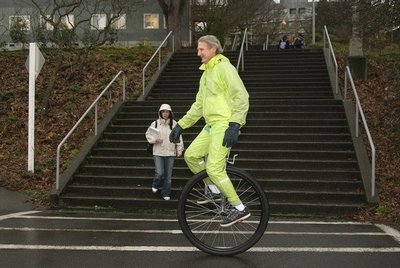January 17, 2008
The Uni-Commuter: One wheel is enough
Greg Harper’s listing in the UW online staff directory reads WIENERHEAD ENGINEER, NUCLEAR PHYSICS LAB. He conducts nuclear physics experiments using particle accelerators and says “way cool” and “groovy” with the same ease as he does “radionuclide” and “transmutation.” He also rides unicycles. As a child, Harper read Mechanix Illustrated, which is where, in 1964, he came across the article “How to Build and Ride a Unicycle” and began his lifelong relationship with one-wheeled vehicles.
Physics and unicycles are natural interests for Harper, a lanky six-foot-one research scientist who loves learning how things work. Wearing an 80s faded teal and pink sweatshirt with the periodic table of elements and words “Nuclear Physics Laboratory, University of Washington” and a plan view of the lab printed across the front, Harper animatedly describes unicycling mechanics. His arms wave about like a conductor’s while he explains that unicycles are like fixed-gear bicycles, making coasting impossible.
“But it’s harder than biking because unicyclists constantly need to balance on the forward-backwards axis and twist in order to maintain position while steering,” he adds.
As a “uni-commuter,” Harper steers his way from his Crown Hill home to the University of Washington Nuclear Physics Lab every spring, summer and fall day that it’s not raining, averaging ten miles an hour over his five-mile route.
“It’s primarily that slow because my route has eleven traffic signals and nine stop signs,” says Harper. “And the two hills: I have measured those and they are about fifteen percent grade.”
Fifteen percent grade is the unicycling equivalent of a double-black-diamond ski run. First-time unicyclists take an average of ten to twenty hours to complete one full-pedal rotation without falling off.
“But as long as you keep your weight on the seat, look ahead instead of down, and maintain good posture while riding, you probably won’t have a ‘UPD’ — unplanned dismount. We like to say that instead of ‘I fell.'”
Harper likes precision. He tinkers with gears, works at the atomic level, and when talking immediately editing his words if he’s unsatisfied with them. So when Harper says he’s knowledgeable about unicycling, that’s exactly what he means: he knows its origin and pioneers, its slang and breakthroughs.
“A few weeks ago,” he says, “there was a guy named Sam Wakeling in Great Britain who rode 282 miles and broke the twenty-four hour distance record for unicycling.”
In characteristic detail, he explains the origins of unicycling. “The most respected theory is that it was derived in the late-1800s from the penny-farthing, the bicycle with the big front wheel and tiny rear wheel.”
Throughout most of the 1900s, street performers comprised most of the unicycling community, but Harper quickly points out that unicycling is not limited to street and circus performers, the stereotype that he says probably annoys riders the most. Feigning the confused look of a tourist, he says in a valley-girl tone, “‘Are you, like, with the circus?'”
In the late-1900s, riders started experimenting with different types of unicycling models and styles, such as hard-terrain unicycling, which George Peck pioneered in the 1970s on the beaches near his Seward, Ala., home.
“When he started riding on rocky beaches, he started breaking things,” Harper explains. Peck structurally altered his unicycle to withstand the rough terrain near his home, and the mountain unicycle, or “MUni,” was born.
In trials unicycling, riders jump off objects, go up objects and ride along elevated skinny rails, pipes and — in Harper’s case — curbs.
“During my commute, I’ll ride my unicycle on the four-inch curbs of Ravenna Boulevard for hundreds of yards trying to maintain balance. It’s a treat. Doing something like that’s a lot of fun.”
Harper’s more than a unicycle commuter and savant; he’s also an inventor, designing and building the first practical geared unicycle one day before Frank Bonsch, an enthusiast in Germany, finished one of a similar design.
He also plays an active role in the local and online unicycling community, posting over 4,500 threads in the last six years on www.unicycling.com, a popular online forum, and regularly goes on long rides with other Seattle-area unicyclists, some of whom are Harper’s co-workers.
Most unicyclists, Harper says, start when they’re between 12 and 18 years old.
“They learn fast, they’re indestructible, and it’s usually before they start driving and dating.”
Some join unicycling teams, like the Panther Pride Unicycle Demo Team in North Bend, and participate in parades, perform at basketball half-time shows and train for unicycle meets, sometimes doing entire plays or musicals while on unicycle.
Harper is as light-hearted and quick-witted as he is intense. He was riding near campus one day when a girl leaned out of a car window and yelled, “Hey buddy, can I take your picture?” Without missing a beat, Harper replied, “Don’t you mean, ‘Hey stud, can I take your picture?'” Harper gets stares — “lots and lots” — during his commute, and is used to drivers slowing down to take cell phone pictures of him.
“But I’ve only caused one accident so far that I know of,” he says.
Harper has ridden unicycles since he was eleven, but only began uni-commuting in 2000, the year his wife and kids bought him a new unicycle for his birthday, reviving his interest in the sport. Today he owns eight unicycles, some of which he uses for competitions. He describes a trials competition he joined in Minnesota:
“For my age group, I did really well.” He paused. Then, proudly, “I was my age group.”

